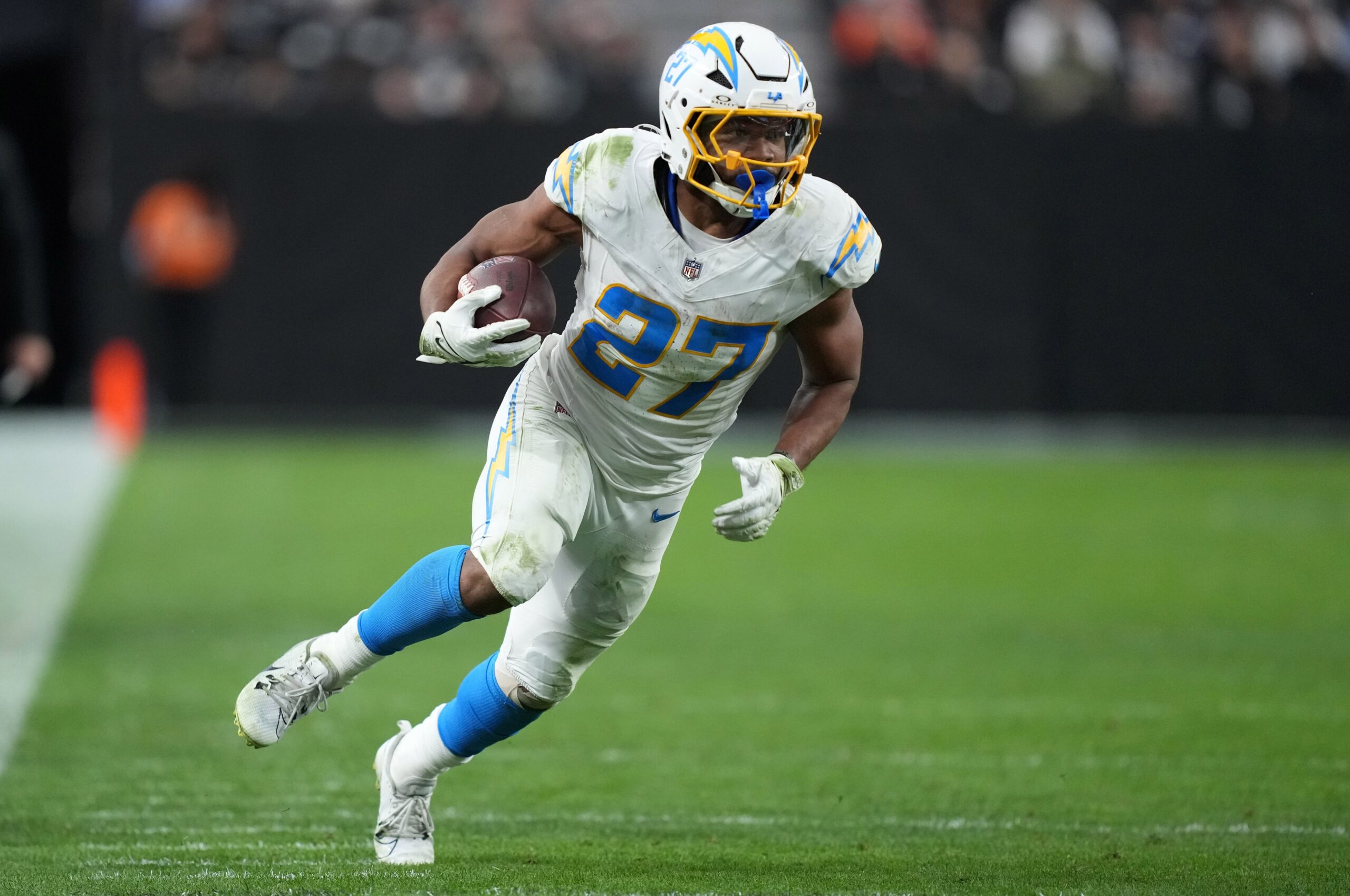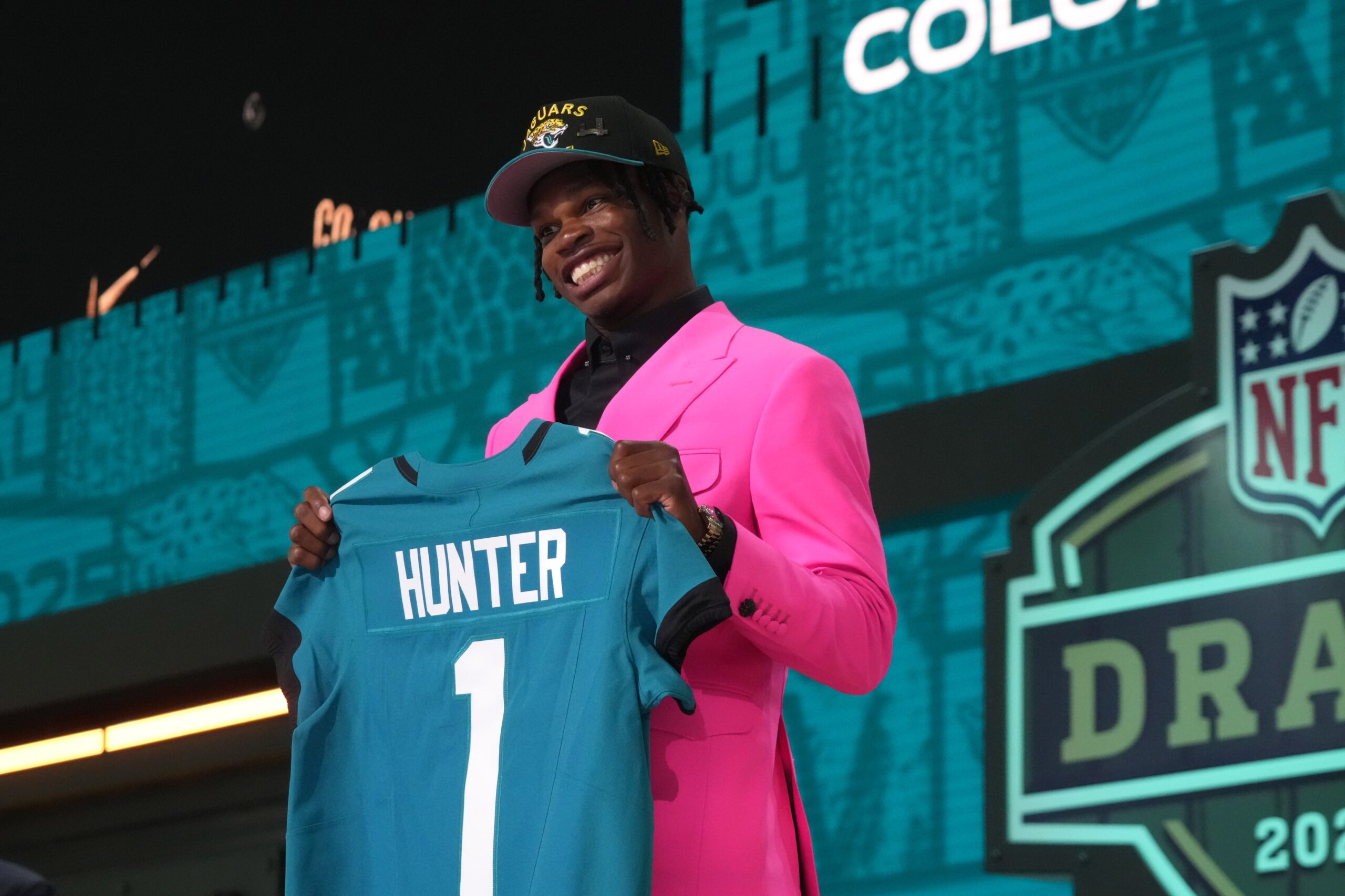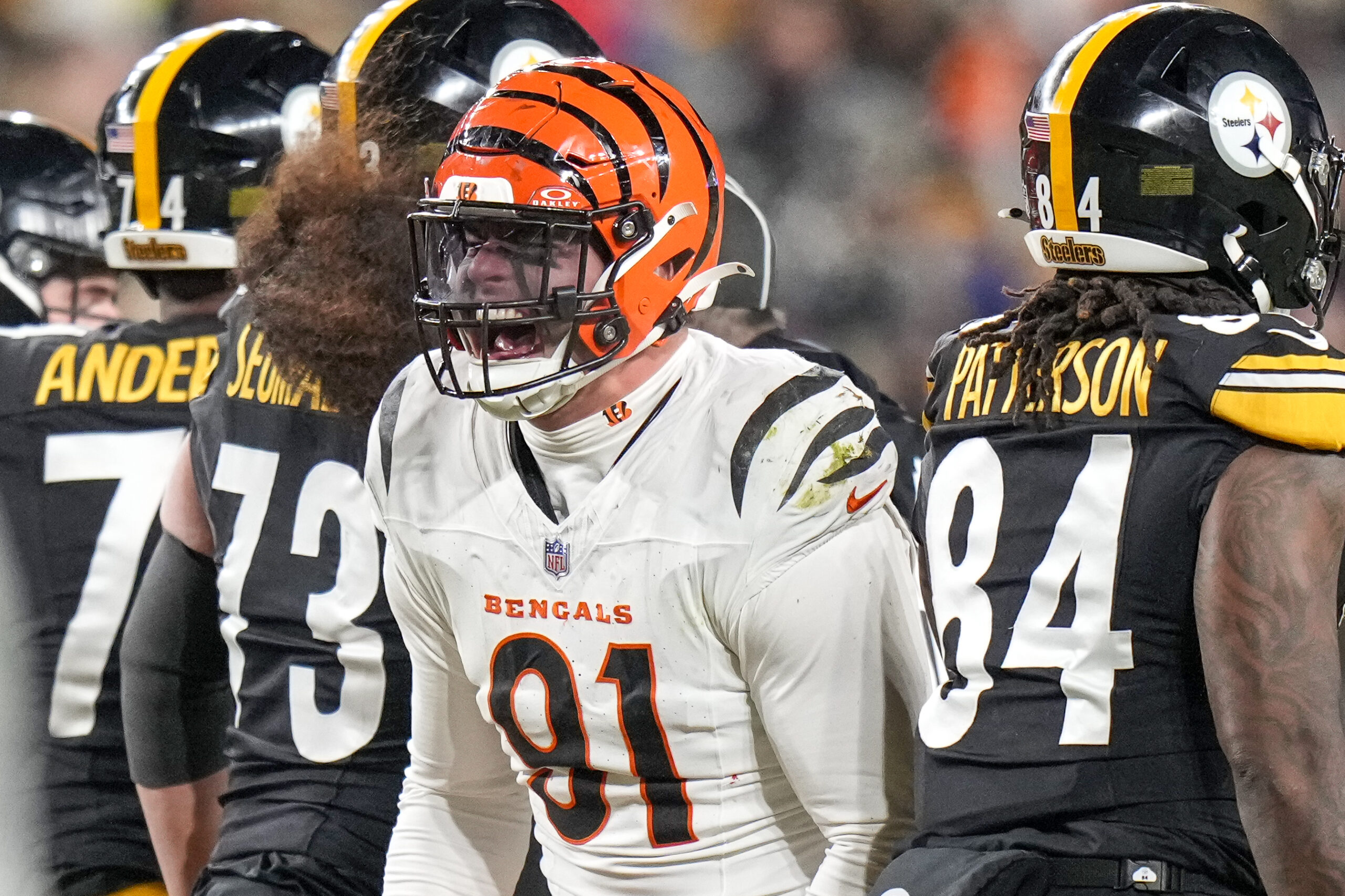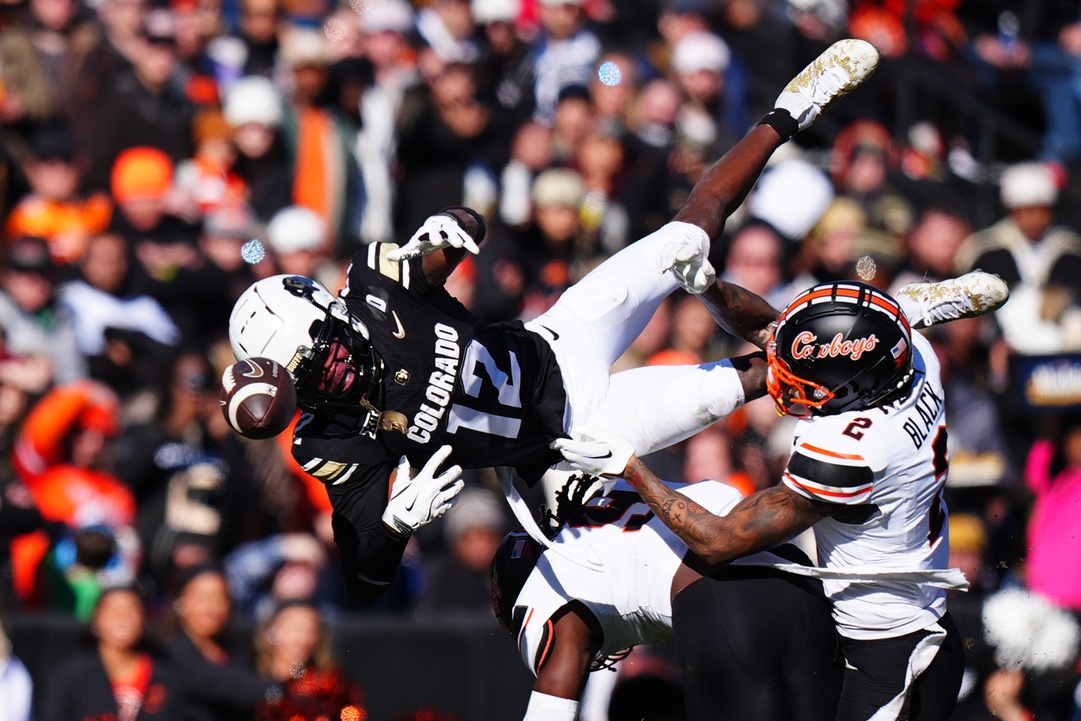NFL Analysis
10/7/24
21 min read
1st & 10 Week 5: Lamar vs Burrow, 49ers Woes, Stroud vs Allen & More

Week 5 might have been our craziest week yet. Not only did it start at 9:30 am Eastern and go until about 1 am, but all of the games were wild. We have a lot to cover, so let’s get to it.
Each week, 1st & 10 will bring you a Monday morning in-depth breakdown of everything you need to know from Sunday’s slate of games. We’ll fill this column with stats, film, and plenty of words to keep you covered on anything you might have missed or want to dive deeper into from Sunday.
All stats provided by TruMedia unless noted otherwise
1st & 10 NFL Week 5
1. Lamar Jackson And Joe Burrow Battled
The Baltimore Ravens and Cincinnati Bengals haven’t always delivered entertaining games despite being among the best rivals between for the past few seasons. With strong defensive performances in previous meetings, we’ve gotten some AFC North slugfests.
However, the Ravens' 41-38 overtime win in Week 5 was about as exciting as it gets. Lamar Jackson and Joe Burrow combined for 740 yards and nine touchdowns. They were the second and fourth-best quarterbacks by EPA per play this week.
The Bengals were up multiple scores at separate points in this game, and the offense looked like the version that went to the Super Bowl a few years ago. Burrow had his most explosive passing day (19 percent), and he also threw the ball for his highest average depth of target on the season (8.3 yards).
This was the best version of Burrow, a quarterback who can get the ball out quickly to pick apart holes in a defense but also take shots when they’re given. Everything worked as well as the Bengals could have hoped.
Ja’Marr Chase had a monster day with 193 yards and two touchdowns on 10 receptions, including a 41-yard touchdown from the slot in a trips alignment right before the half.
Chase also took a screen 70 yards to put the Bengals up by 10 in the fourth quarter.
Tee Higgins had two touchdowns of his own, and then Burrow made nice deep passes to Andrei Iosivas and Mike Gesicki. This offense couldn’t have asked for much more. After a slow start, the Bengals rank second in EPA per play and success rate on offense for the season behind the Washington Commanders.
The Bengals controlled much of this game but fell off at the end. With three minutes remaining, a quick slant intended for Chase was left a little inside and intercepted by Marlon Humphry. That set up a game-tying field goal for the Ravens in regulation.
Then, after an overtime fumble, the Bengals got the ball for a first-and-10 on the Ravens’ 38-yard line. Cincinnati conservatively ran the ball three times and gained just three yards. On a 53-yard field goal attempt, the hold was messed up, and the kick was no good.
On the next play, Derrick Henry ran for 51 yards, putting the Ravens on the 6-yard line for a field goal that won the game.
Cincinnati's biggest problem remains the defense, which could not consistently slow down the Ravens. The Bengals came into the game focused on stopping the run and did so for much of the game.
Cincinnati played more base and stacked the box more often than they had in the first four weeks of the season. The strategy worked. Through the end of regulation, Ravens running backs averaged just 2.9 yards per carry. Yet, that big Henry run shifted the end of the game.
Without a running game, as the Bengals sold out to stop it, the Ravens leaned on Lamar Jackson in the passing game, and the reigning MVP delivered. Jackson had 348 yards and four touchdowns as a passer and added 55 yards on the ground.

Jackson averaged 0.46 EPA per play and 9.2 yards per attempt on plays inside the pocket, mastering the rhythm of throwing against the Cincinnati defense. He threw a third of his passes into the intermediate level of the field (11-19) air yards and completed 64.3 percent of those throws.
Of course, Jackson created some playmaking magic, and his best throws were made on the run, such as the touchdown pass to Rashod Bateman in the second quarter.
His best play of the day featured a fumbled snap, stiff-arming a defender, scrambling around, firing a pass near the sideline, and finding Isaiah Likely in the end zone to bring the Ravens within three points in the fourth quarter.
Jackson is now third in EPA per play through the Sunday games in Week 5 and is off to a significantly better start than last season when he eventually won the MVP.

With the Steelers’ loss on Sunday Night Football, the Ravens jumped into first place in the AFC North. They have intriguing matchups with the Commanders and Buccaneers during the next two weeks.
Even with a Bengals loss at 1-4, Cincinnati plays the Giants, Browns, Eagles, and Raiders for their next four games before meeting the Ravens again in Week 10. It’s possible the Bengals will have pulled themselves to a better record and within reach of a playoff spot by the time this rematch rolls around.

2. Should We Be Worried About the 49ers?
Brock Purdy had been playing some impressive football without his full complement of playmakers on offense. Christian McCaffrey has yet to suit up for San Francisco. Brandon Aiuyk has been slow to ramp up after missing much of the offseason while holding out for a new contract. Deebo Samuel and George Kittle both missed time.
Everyone except McCaffrey was on the field in Week 5, and the San Francisco 49ers lost 24-23 to the Arizona Cardinals. The 49ers are 2-3 and, by playoff seeding with tiebreaks, are 14th in the NFC. That’s an exaggeration of where San Francisco stands, but it’s clear this is not a team running through its opponents, as was the case last season.
The loss to Arizona was San Francisco’s second in three weeks, with a lead in the fourth quarter and a late opponent comeback. In Week 3 against the Los Angeles Rams, the 49ers peaked at a 97 percent win probability with 4:57 remaining, up 24-17 according to the Next Gen Stats model. The Rams won 27-24 in regulation.
Against the Cardinals, the 49ers only peaked at an 88 percent win probability with 6:20 left, up 23-21, but that came on a first-and-goal from the Arizona 8-yard line. The next play was a Jordan Mason fumble recovered by the Cardinals. Arizona drove down the field for a go-ahead field goal. Then, Purdy threw an interception on the ensuing drive that clinched the game for the Cardinals.
It’s not just one thing that went wrong or a bad call that flipped the game. What might be more concerning for the 49ers is it’s just a bunch of little things not working well and leading to these blown leads.
Kicker Jake Moody's Injury
The 49ers blocked a punt for a touchdown, but on the kickoff that followed, Moody attempted a tackle and was injured on the play. He did not return, and it was revealed he suffered a high ankle sprain that would keep him out for weeks.
With Moody out, Kyle Juszczyk took some warmup kicks into the net, but punter Mitch Wishnowsky took over the kicking duties while the fullback held. On the next drive, Wishnowsky kicked a 26-yard field goal.
However, on a drive in the third quarter, the 49ers faced a fourth-and-23 from the Arizona 27-yard line. That was too far for a Wishnowsky attempt, so the Niners went for it and failed with an incomplete pass. Arizona took over on downs and scored a touchdown on that following drive.
Unforced Errors
On the touchdown after the failed fourth down, the 49ers committed a roughing the passer penalty after Kyler Murray released the ball to an open Elijah Higgins.
Down four at the time of the touchdown, the Cardinals elected to use the penalty to attempt a 2-point conversion from the 1-yard line. The successful conversion put Arizona down by two points and allowed the final field goal to put it in the lead instead of tying the game.
Red Zone Woes
San Francisco reached the red zone on six of its nine drives but only came away with one touchdown. Through Week 4, the 49ers reached the red zone on 41 percent of their drives (fourth) but scored a touchdown on half of those (20th).
This might be where the 49ers miss McCaffrey the most. San Francisco has run the most red zone plays this season, and it averages -0.19 EPA per play with a 35.7 percent success rate, which ranks 25th. Last season, the 49ers had a league-high 55.3 percent success rate.
McCaffrey had a league-high 63 red zone carries with 13 rushing touchdowns, a 22.9 percent target share, and five receiving touchdowns in the red zone last season.
In a vacuum, these are all small things, but they’ve continually added up. The 2024 team's margin for error is much smaller than it was last season, and we’re seeing how little mistakes or bad breaks can turn a game. San Francisco might turn out ok, but the 49ers will have to earn it to get close to another playoff run.

3. Texans And Bills Are Flawed contenders
Entering the season, the Houston Texans and Buffalo Bills were expected to be top contenders in the AFC. After a 23-20 Houston win against Buffalo in Week 5, the Texans sit at 4-1 with the Bills at 3-2.
Buffalo is still atop the AFC East and has the league's fourth-best point differential. Houston, while having just one loss, is 24th in point differential at -12. These are two flawed AFC contenders, and we saw some of the reasons for this throughout Sunday’s matchup.
Last week in 1st & 10, we wrote about how the Texans still had an early down problem, and that continued into Week 5. Houston faced an average third down of 7.2 yards to go, and that was its second-best figure of the season. On third downs, C.J. Stroud was 9-of-14 for 151 yards with a 60 percent success rate.
The Texans are 29th in EPA per play on early downs (-0.14) and fifth in EPA per play on third down (0.21).

Stroud was phenomenal in this game despite averaging -0.10 EPA per play. He made several would-be sacks disappear. He took seven hits but just one sack, with a 6.7 percent pressure-to-sack rate. Against the blitz, Stroud was 8-of-9 for 120 yards and 1.13 EPA per play.
He consistently threw with touch and anticipation. His 67-yard touchdown throw to Nico Collins was a perfectly placed ball, with Collins splitting the cornerback and deep safety.
When Collins left the game, Stroud relied on Tank Dell and Stefon Diggs ( six catches for 82 yards against his former team), but this team has more often been the quarterback bailing out the offense.
Josh Allen has often been that for the Bills but couldn’t do that against Houston. With Khalil Shakir out, Buffalo’s lack of depth at receiver showed — Mack Hollins tied Dalton Kincaid for the team lead in targets with six.
The Bills' offense felt tight without Shakir. Allen tried to hit some big plays to compensate for the lack of down-to-down consistency, but that did not work. Allen had 13 pass attempts that traveled at least 15 air yards, and he did not complete a single one.
He’s had 13 career games with an aDOT of at least 12, and the Week 5 game against the Texans was his lowest completion percentage and average depth of completion among those games.

Despite Allen’s flawed performance, the Bills were still in the game at the end but had massive errors that cost them.
First, Allen suffered what looked to be a head injury in the fourth quarter. He appeared out when his head hit the ground, but he returned for the next series. He did not complete a pass upon his return. That included three straight passes in a tie game with 32 seconds left while the Bills were backed up on their 3-yard line, and Houston had all three timeouts remaining.
Milking the clock and forcing Houston to use its timeouts should have been the course of action. It’s possible the Bills still end up barely gaining yards and punting, but that takes away any middle-of-the-field throws from Houston when the Texans get the ball back.
As it stood, the Bills killed just 25 seconds and gained no yards before a punt. Houston returned the punt 13 yards, got a 5-yard pass to the middle of the field, and called a timeout before a 59-yard field goal from Kaimi Fairbun won the game as time expired.

4. Vikings defense bails out offense
The Minnesota Vikings remain one of two undefeated teams (pending Monday Night Football). Their 23-17 win against the New York Jets in London highlighted the different ways this team could win.
To this point, the defense has been a dominating force, while the offense has been a well-schemed machine that made life easy on Sam Darnold. Only one of those stayed true across the pond.
Darnold had his worst game as a Viking, averaging -0.51 EPA per play with a 30 percent success rate. He completed just 45 percent of his passes while he had his highest aDOT of the season (13.0).
The best Minnesota offensive play was drawing defensive penalties, which were called often. On one touchdown drive in the second quarter, the Vikings benefited from two pass interference penalties and a defensive holding call.
Minnesota's offense was lost when Aaron Jones left the game with an injury. Jones paced the backfield with successful runs and was a useful outlet option in the passing game. Without him, the run game suffered, and the Vikings’ offense cratered overall.

But the defense again came through, bullying Aaron Rodgers and never letting the quarterback or Jets offense overall get settled. Early in the game, Rodgers had a third down conversion against a Minnesota blitz.
Before the snap, he saw the blitz look and called for slants to get the ball out quickly to the outside and away from the rushers. It gained eight yards on a third-and-9, which still forced the Jets to punt despite Rodgers getting a good read on the play.
Here’s the look before the snap:

Two drives later, the Vikings gave Rodgers a similar look on a third-and-6.

But instead of blitzing the seven defenders on the line, Andrew Van Ginkel dropped out into coverage and right into Rodgers' throwing lane, where he wanted to throw a slant behind the blitz.
The Vikings blitzed Rodgers on 40.4 percent of his dropbacks. By volume, Rodgers’s 23 dropbacks against the blitz were the fourth-highest of his career. Two of his top six games have been in the past two weeks.

With the constant extra rushers and pressure, Rodgers does not have enough communication and familiarity with the offense to make the types of plays he’s been used to throughout his career. He averaged -0.63 EPA per play against the blitz and had a 17.6 percent success rate when under pressure.
Passes look off-target, and Rodgers appears uncomfortable in the pocket without consistently being able to move outside of it. The Vikings did not relent or allow the Jets' offense to get any rhythm. That’s been an issue for the Jets regardless of the opponent, but it was apparent against the league’s best, most creative defense.
The Vikings have multiple paths to win games, while the Jets have struggled to find one.

5. Caleb Williams Is Heating Up
Caleb Williams had the best day of his career and continues to improve every week. Against the Panthers (caveat applied) in a 36-10 win, Williams looked comfortable and assertive in the passing game.
He averaged 10.5 yards per attempt, and his 0.35 EPA per attempt was the week's third-best.
Williams connected with DJ Moore for two touchdowns, and the receiver went for 105 yards on the day. The second touchdown to Moore showed some incredible growth and maturity from Williams in the pocket.
The Bears came out in a 2x2 set but motioned TE Cole Kmet to the right side, leaving Moore as the isolated receiver to the left. With the motion, the deep safety on the right dropped down, leaving a single-high deep safety.
After the snap, Williams stared down a vertical route from Keenan Allen to the right side, which brought the deep safety over. He then looked back to Moore and fired a strike for the score.
Williams was only pressured on 17.1 percent of his dropbacks and made plays to avoid defenders when they did come. The Bears are starting to figure out what does and doesn’t work for Williams, and this offense and the weekly improvement are a great sign for the first-overall pick.


6. How Trevor Lawrence Bounced Back
After wondering what was wrong with Trevor Lawrence and the Jacksonville Jaguars offense, he had his third-best day as a passer in his career by EPA per play in Week 5.
Lawrence’s 0.40 EPA per play led all quarterbacks this week, and the Jaguars did it by blending what previously worked with some of the bigger downfield shots the offense had over-relied on in 2024.
Lawrence averaged 2.35 seconds to throw, and that rhythm allowed the quarterback to distribute the ball around efficiently. But unlike the previous season and a half, when the Jaguars used the quick game to run a static offense filled with stop routes, there was room to run after the catch.
Against the Colts, 59.6 percent of his passing yards came after the catch. That’s the eighth-highest rate in his career and the second-highest for a game when he eclipsed 250 passing yards.
With the ball out so quickly, the Jaguars eliminated the potential of pressure. He was pressured on just one drop back in the game. He was also charted with no inaccurate passes, which had been rampant in Lawrence’s game this season.
There were also big plays available, like the 85-yard touchdown to Brian Thomas Jr. in the second quarter. Thomas went vertical from the slot and was open down the sideline.
The Colts' static defense was probably the best opponent to face to get back in a groove. This game at least proved that all might not be lost for the 2024 season, though the Jaguars are still at 1-4, and any upside might be more meaningful for 2025 at best.

7. Did the Cowboys save their season?
A four-yard touchdown pass to Jalen Tolbert on a fourth-and-goal from the 4-yard line was desperately needed for the Dallas Cowboys.
With a loss, Dallas would have dropped to 2-3. While that wouldn’t have been a death sentence for the season, it would not fly for this franchise. Or maybe it would, but it would just be talked about a whole bunch.
With a game against the Detroit Lions next week, a loss to the Steelers could have put the Cowboys at 2-4 heading into a Week 7 bye. That would have been something. But the win gets Dallas to 3-2 and at least a .500 record at worst at the bye.
The game against Pittsburgh was up and down. Dak Prescott threw for more than 350 yards and two touchdowns but also had two interceptions and appeared to have a verbal disagreement with CeeDee Lamb on the sideline — or more like Lamb had a verbal disagreement with Prescott present.
Prescott averaged 0.11 EPA per play and had a 51.1 percent success rate, but the 19 points and need for the last-second touchdown to win overshadowed a relatively impressive performance.
The defense had its best day, holding Justin Fields to 4.9 yards per attempt and Najee Harris to 3.0 yards per carry. That might not mean the defense is fixed. It's still 23rd in EPA per play, but it was better than what the Cowboys had shown outside of the season opener against the Browns.

8. Player Spotlight: Xavier McKinney
There were not many big contracts given out to safeties this offseason.
That market has mostly plateaued, but the Packers signed Xavier McKinney to a four-year, $67 million contract to take charge of the back end of the secondary. McKinney has done just that. He has an interception in all five games for the Packers — he’s the first player to do that in his first five games with a new team.
He’s doing this mostly playing a post-safety role. This year, 78.4 percent of his snaps have come as a deep safety, and 39.4 percent have been as a single-high safety. The Packers have been in the middle of the pack in single-high and two-high coverages.
McKinney’s range has been a key to allowing the defense to live in both worlds.
His range from deep is incredible, and his reads on passes are key to his interception streak. Look at where he’s come from on three of his five picks.

Going back to Week 18 of the 2023 season, when he picked off Jalen Hurts and Marcus Mariota, McKinney has an interception in six straight regular season games. That ties the most for a player since 2000.
For a single season, he could tie Trevon Diggs, Brian Russell, and Doug Evans with an interception in six straight games if he picks off Kyler Murray next week.

9. Play of the day
Shoutout to Isaiah Simmons for doing his best Kam Chancellor and Bobby Wagner impression in Seattle. Simmons jumped the snap and blocked a would-be game-tying field goal that was returned for a touchdown and clinched a New York Giants win against the Seahawks.
Another shoutout to Dexter Lawrence and Rakeem Nunez-Roches for pushing down Seattle’s linemen to make the leap easier for Simmons. According to the NFL, “pushing down alone is not a foul, and there was no forcible contact to the head and neck,” making that play legal.

10. Deshaun Watson Isn’t Going Anywhere
“We’re not changing quarterbacks,” Kevin Stafanski said in his post-game press conference.
Cleveland lost 34-13 to Washington as Deshaun Watson again looked like the league's worst quarterback, incapable of running any type of competent offense.
At -0.36 EPA per play for the season, Watson joins Mac Jones in 2023 as the only quarterback since 2000 to have at least 150 dropbacks and worse than -0.35 EPA per play through the first five weeks of the season.
Watson continually hangs onto the ball and is now the only quarterback to be hit at least 10 times in three separate games this season. The Browns’ offensive line battling through injuries, but the quarterback makes that worse.
Each week, Watson and Amari Cooper look like it’s the first time they’ve played together. Cooper had four receptions on 10 targets in Week 5.
There’s too much invested in Watson for a benching to happen this early in the season. He still has guaranteed salaries of $46 million in each of the next two seasons. A post-June 1 cut next offseason would leave nearly $119 million in dead money on the Browns' cap while having to pay out the guaranteed salaries in cash.
The biggest on-field problem for the Browns is that they have nothing to lean into. Watson was always a strange fit for the Stenfanski under-center play-action offense, so they brought in Ken Dorsey this season to install some more empty packages and get Watson comfortable there.
Watson has been in empty on a league-high 27.6 percent of his dropbacks. On those snaps, he’s averaged -0.35 EPA per play with a 32.3 percent success rate and 4.9 yards per attempt.
Overall, he’s last in EPA per play and success rate among qualified quarterbacks this season.
It won't get better, and nothing will change.








